Global Wicked Problems: Pollution Reduction Campaigns Analysis
VerifiedAdded on 2023/06/14
|9
|2769
|210
Report
AI Summary
This report examines environmental pollution as a 'wicked problem,' highlighting the challenges in completely resolving it and emphasizing the importance of continuous reduction efforts. It analyzes two campaigns: Toyota's global initiatives to reduce vehicle emissions through electric vehicles and smog-reducing billboards, and New Delhi's 'Clean Air Campaign' aimed at curbing local pollution levels. The analysis includes the successes of these campaigns in reducing pollution and raising awareness, as well as unintended consequences such as the high cost of electric vehicles, limitations in smog-reducing billboard implementation, and disruptions caused by Delhi's 'Even-Odd' rule. The report concludes that while these campaigns have made significant strides, ongoing and evolving strategies are necessary to address the persistent and complex nature of environmental pollution.
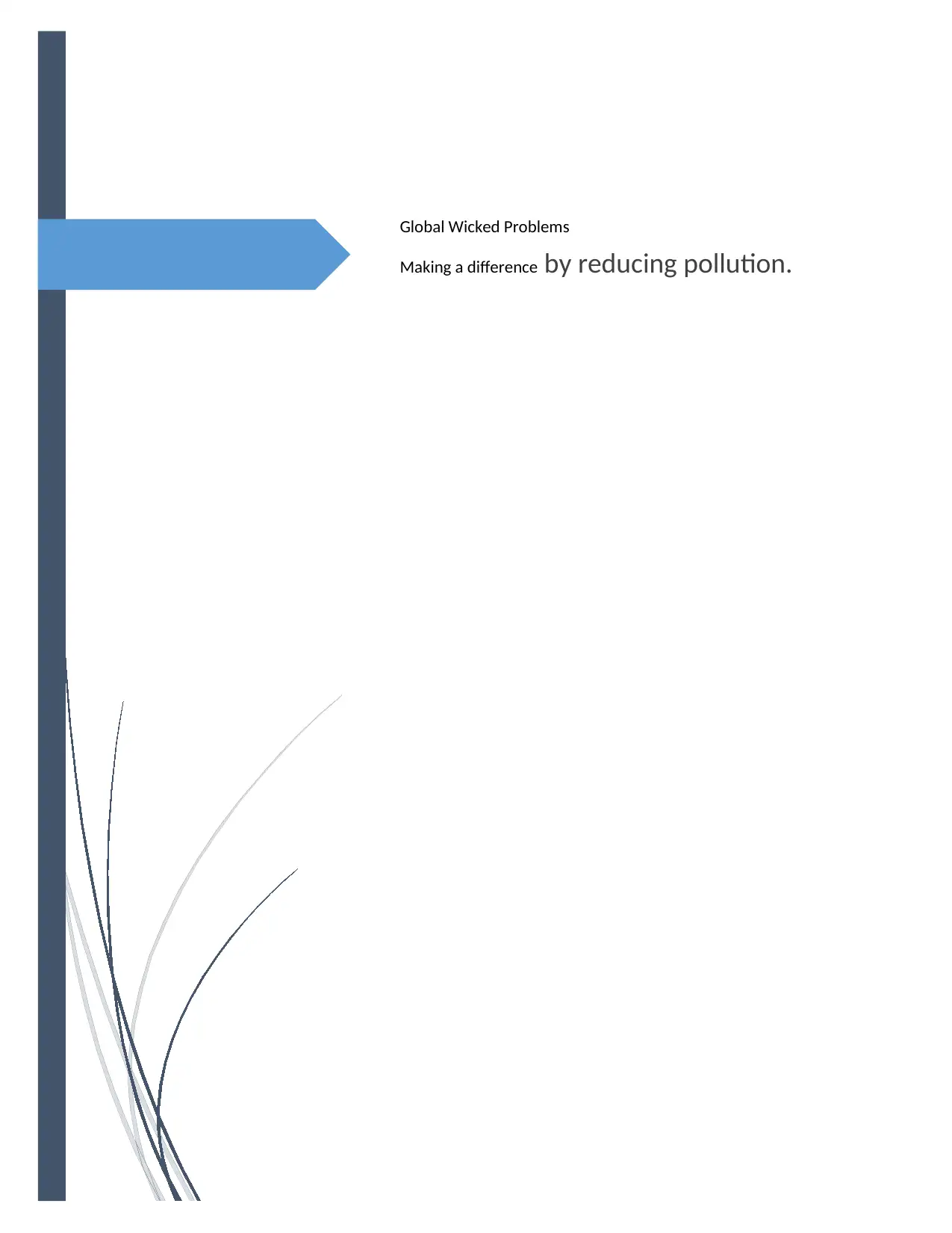
Global Wicked Problems
Making a difference by reducing pollution.
Making a difference by reducing pollution.
Paraphrase This Document
Need a fresh take? Get an instant paraphrase of this document with our AI Paraphraser
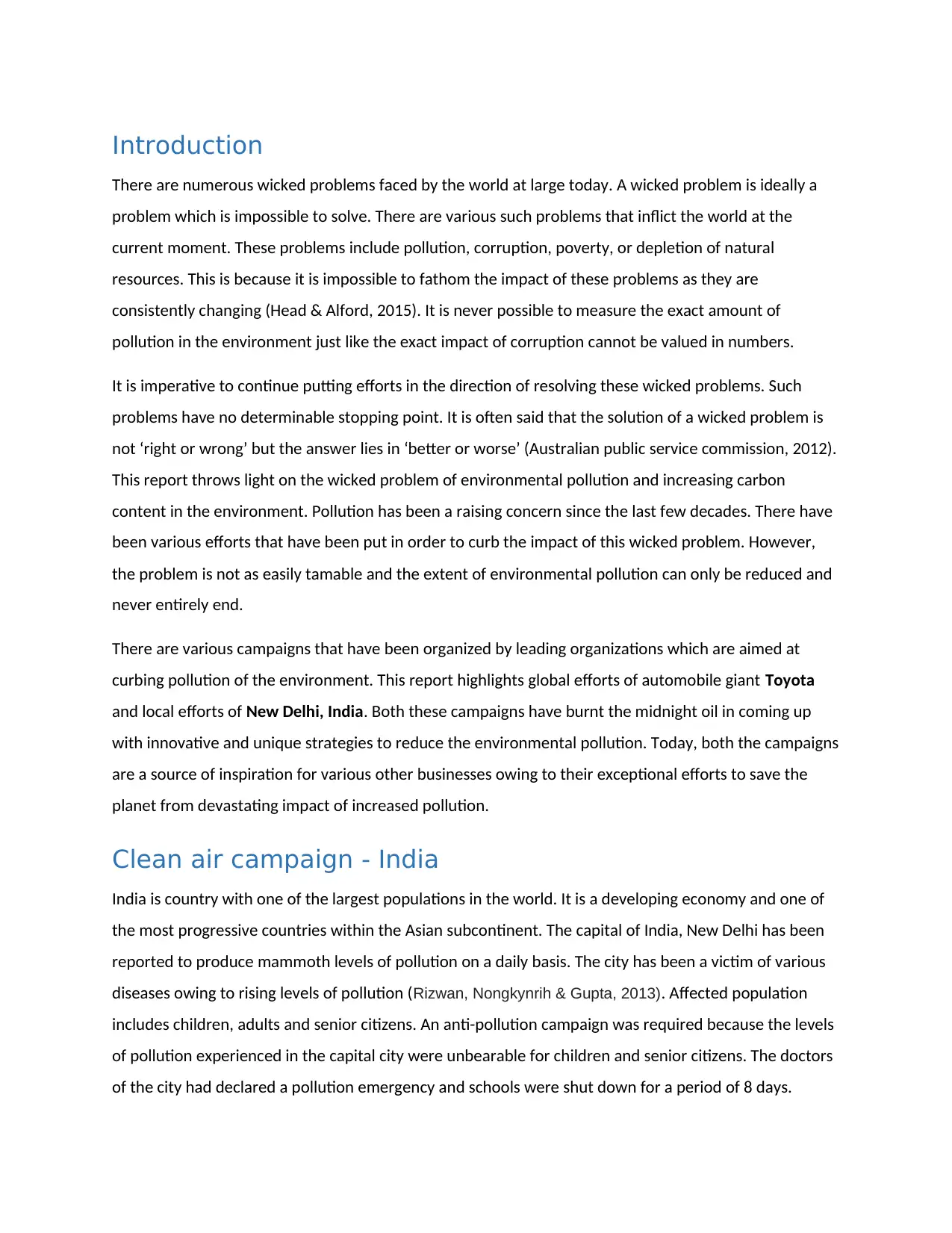
Introduction
There are numerous wicked problems faced by the world at large today. A wicked problem is ideally a
problem which is impossible to solve. There are various such problems that inflict the world at the
current moment. These problems include pollution, corruption, poverty, or depletion of natural
resources. This is because it is impossible to fathom the impact of these problems as they are
consistently changing (Head & Alford, 2015). It is never possible to measure the exact amount of
pollution in the environment just like the exact impact of corruption cannot be valued in numbers.
It is imperative to continue putting efforts in the direction of resolving these wicked problems. Such
problems have no determinable stopping point. It is often said that the solution of a wicked problem is
not ‘right or wrong’ but the answer lies in ‘better or worse’ (Australian public service commission, 2012).
This report throws light on the wicked problem of environmental pollution and increasing carbon
content in the environment. Pollution has been a raising concern since the last few decades. There have
been various efforts that have been put in order to curb the impact of this wicked problem. However,
the problem is not as easily tamable and the extent of environmental pollution can only be reduced and
never entirely end.
There are various campaigns that have been organized by leading organizations which are aimed at
curbing pollution of the environment. This report highlights global efforts of automobile giant Toyota
and local efforts of New Delhi, India. Both these campaigns have burnt the midnight oil in coming up
with innovative and unique strategies to reduce the environmental pollution. Today, both the campaigns
are a source of inspiration for various other businesses owing to their exceptional efforts to save the
planet from devastating impact of increased pollution.
Clean air campaign - India
India is country with one of the largest populations in the world. It is a developing economy and one of
the most progressive countries within the Asian subcontinent. The capital of India, New Delhi has been
reported to produce mammoth levels of pollution on a daily basis. The city has been a victim of various
diseases owing to rising levels of pollution (Rizwan, Nongkynrih & Gupta, 2013). Affected population
includes children, adults and senior citizens. An anti-pollution campaign was required because the levels
of pollution experienced in the capital city were unbearable for children and senior citizens. The doctors
of the city had declared a pollution emergency and schools were shut down for a period of 8 days.
There are numerous wicked problems faced by the world at large today. A wicked problem is ideally a
problem which is impossible to solve. There are various such problems that inflict the world at the
current moment. These problems include pollution, corruption, poverty, or depletion of natural
resources. This is because it is impossible to fathom the impact of these problems as they are
consistently changing (Head & Alford, 2015). It is never possible to measure the exact amount of
pollution in the environment just like the exact impact of corruption cannot be valued in numbers.
It is imperative to continue putting efforts in the direction of resolving these wicked problems. Such
problems have no determinable stopping point. It is often said that the solution of a wicked problem is
not ‘right or wrong’ but the answer lies in ‘better or worse’ (Australian public service commission, 2012).
This report throws light on the wicked problem of environmental pollution and increasing carbon
content in the environment. Pollution has been a raising concern since the last few decades. There have
been various efforts that have been put in order to curb the impact of this wicked problem. However,
the problem is not as easily tamable and the extent of environmental pollution can only be reduced and
never entirely end.
There are various campaigns that have been organized by leading organizations which are aimed at
curbing pollution of the environment. This report highlights global efforts of automobile giant Toyota
and local efforts of New Delhi, India. Both these campaigns have burnt the midnight oil in coming up
with innovative and unique strategies to reduce the environmental pollution. Today, both the campaigns
are a source of inspiration for various other businesses owing to their exceptional efforts to save the
planet from devastating impact of increased pollution.
Clean air campaign - India
India is country with one of the largest populations in the world. It is a developing economy and one of
the most progressive countries within the Asian subcontinent. The capital of India, New Delhi has been
reported to produce mammoth levels of pollution on a daily basis. The city has been a victim of various
diseases owing to rising levels of pollution (Rizwan, Nongkynrih & Gupta, 2013). Affected population
includes children, adults and senior citizens. An anti-pollution campaign was required because the levels
of pollution experienced in the capital city were unbearable for children and senior citizens. The doctors
of the city had declared a pollution emergency and schools were shut down for a period of 8 days.
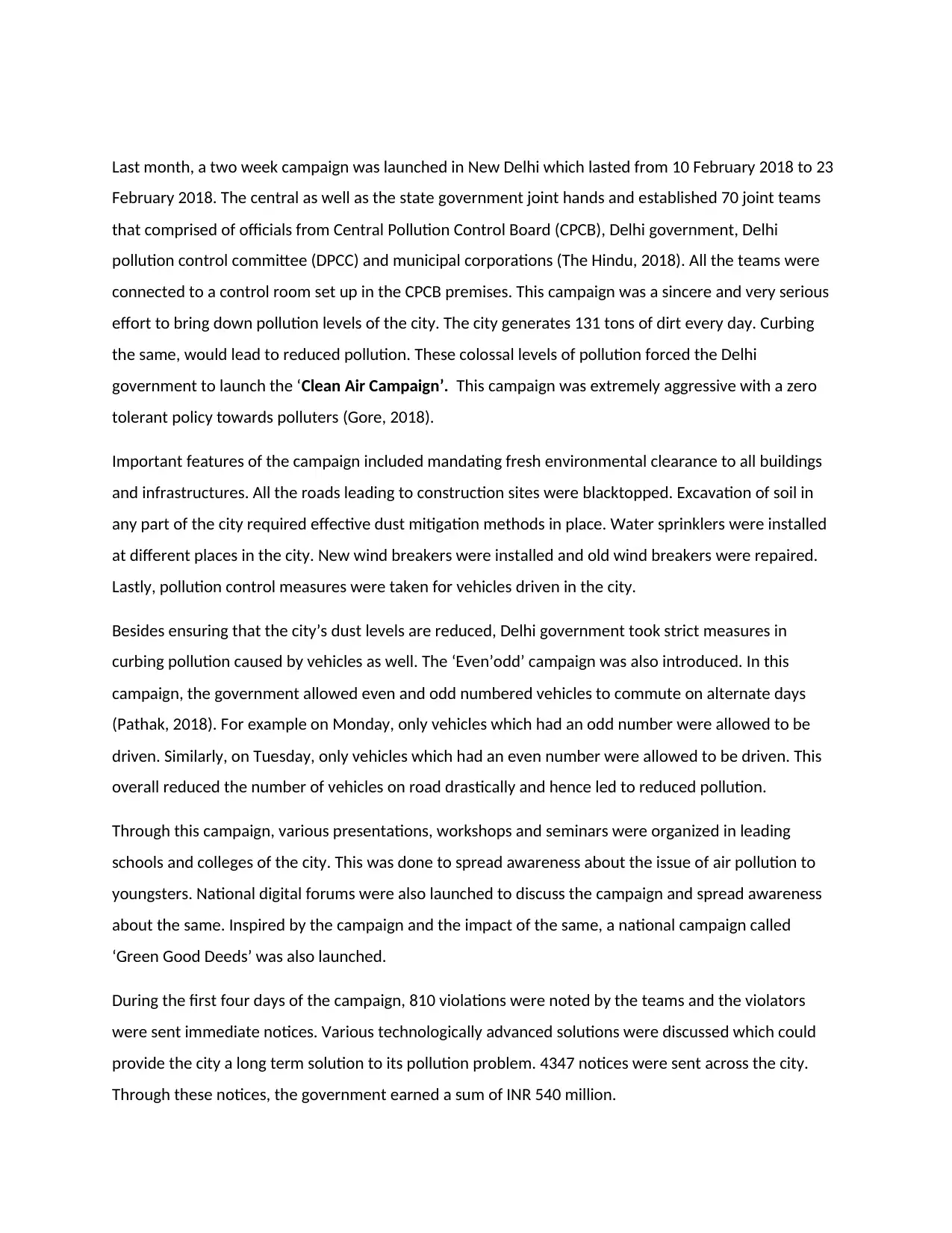
Last month, a two week campaign was launched in New Delhi which lasted from 10 February 2018 to 23
February 2018. The central as well as the state government joint hands and established 70 joint teams
that comprised of officials from Central Pollution Control Board (CPCB), Delhi government, Delhi
pollution control committee (DPCC) and municipal corporations (The Hindu, 2018). All the teams were
connected to a control room set up in the CPCB premises. This campaign was a sincere and very serious
effort to bring down pollution levels of the city. The city generates 131 tons of dirt every day. Curbing
the same, would lead to reduced pollution. These colossal levels of pollution forced the Delhi
government to launch the ‘Clean Air Campaign’. This campaign was extremely aggressive with a zero
tolerant policy towards polluters (Gore, 2018).
Important features of the campaign included mandating fresh environmental clearance to all buildings
and infrastructures. All the roads leading to construction sites were blacktopped. Excavation of soil in
any part of the city required effective dust mitigation methods in place. Water sprinklers were installed
at different places in the city. New wind breakers were installed and old wind breakers were repaired.
Lastly, pollution control measures were taken for vehicles driven in the city.
Besides ensuring that the city’s dust levels are reduced, Delhi government took strict measures in
curbing pollution caused by vehicles as well. The ‘Even’odd’ campaign was also introduced. In this
campaign, the government allowed even and odd numbered vehicles to commute on alternate days
(Pathak, 2018). For example on Monday, only vehicles which had an odd number were allowed to be
driven. Similarly, on Tuesday, only vehicles which had an even number were allowed to be driven. This
overall reduced the number of vehicles on road drastically and hence led to reduced pollution.
Through this campaign, various presentations, workshops and seminars were organized in leading
schools and colleges of the city. This was done to spread awareness about the issue of air pollution to
youngsters. National digital forums were also launched to discuss the campaign and spread awareness
about the same. Inspired by the campaign and the impact of the same, a national campaign called
‘Green Good Deeds’ was also launched.
During the first four days of the campaign, 810 violations were noted by the teams and the violators
were sent immediate notices. Various technologically advanced solutions were discussed which could
provide the city a long term solution to its pollution problem. 4347 notices were sent across the city.
Through these notices, the government earned a sum of INR 540 million.
February 2018. The central as well as the state government joint hands and established 70 joint teams
that comprised of officials from Central Pollution Control Board (CPCB), Delhi government, Delhi
pollution control committee (DPCC) and municipal corporations (The Hindu, 2018). All the teams were
connected to a control room set up in the CPCB premises. This campaign was a sincere and very serious
effort to bring down pollution levels of the city. The city generates 131 tons of dirt every day. Curbing
the same, would lead to reduced pollution. These colossal levels of pollution forced the Delhi
government to launch the ‘Clean Air Campaign’. This campaign was extremely aggressive with a zero
tolerant policy towards polluters (Gore, 2018).
Important features of the campaign included mandating fresh environmental clearance to all buildings
and infrastructures. All the roads leading to construction sites were blacktopped. Excavation of soil in
any part of the city required effective dust mitigation methods in place. Water sprinklers were installed
at different places in the city. New wind breakers were installed and old wind breakers were repaired.
Lastly, pollution control measures were taken for vehicles driven in the city.
Besides ensuring that the city’s dust levels are reduced, Delhi government took strict measures in
curbing pollution caused by vehicles as well. The ‘Even’odd’ campaign was also introduced. In this
campaign, the government allowed even and odd numbered vehicles to commute on alternate days
(Pathak, 2018). For example on Monday, only vehicles which had an odd number were allowed to be
driven. Similarly, on Tuesday, only vehicles which had an even number were allowed to be driven. This
overall reduced the number of vehicles on road drastically and hence led to reduced pollution.
Through this campaign, various presentations, workshops and seminars were organized in leading
schools and colleges of the city. This was done to spread awareness about the issue of air pollution to
youngsters. National digital forums were also launched to discuss the campaign and spread awareness
about the same. Inspired by the campaign and the impact of the same, a national campaign called
‘Green Good Deeds’ was also launched.
During the first four days of the campaign, 810 violations were noted by the teams and the violators
were sent immediate notices. Various technologically advanced solutions were discussed which could
provide the city a long term solution to its pollution problem. 4347 notices were sent across the city.
Through these notices, the government earned a sum of INR 540 million.
⊘ This is a preview!⊘
Do you want full access?
Subscribe today to unlock all pages.

Trusted by 1+ million students worldwide
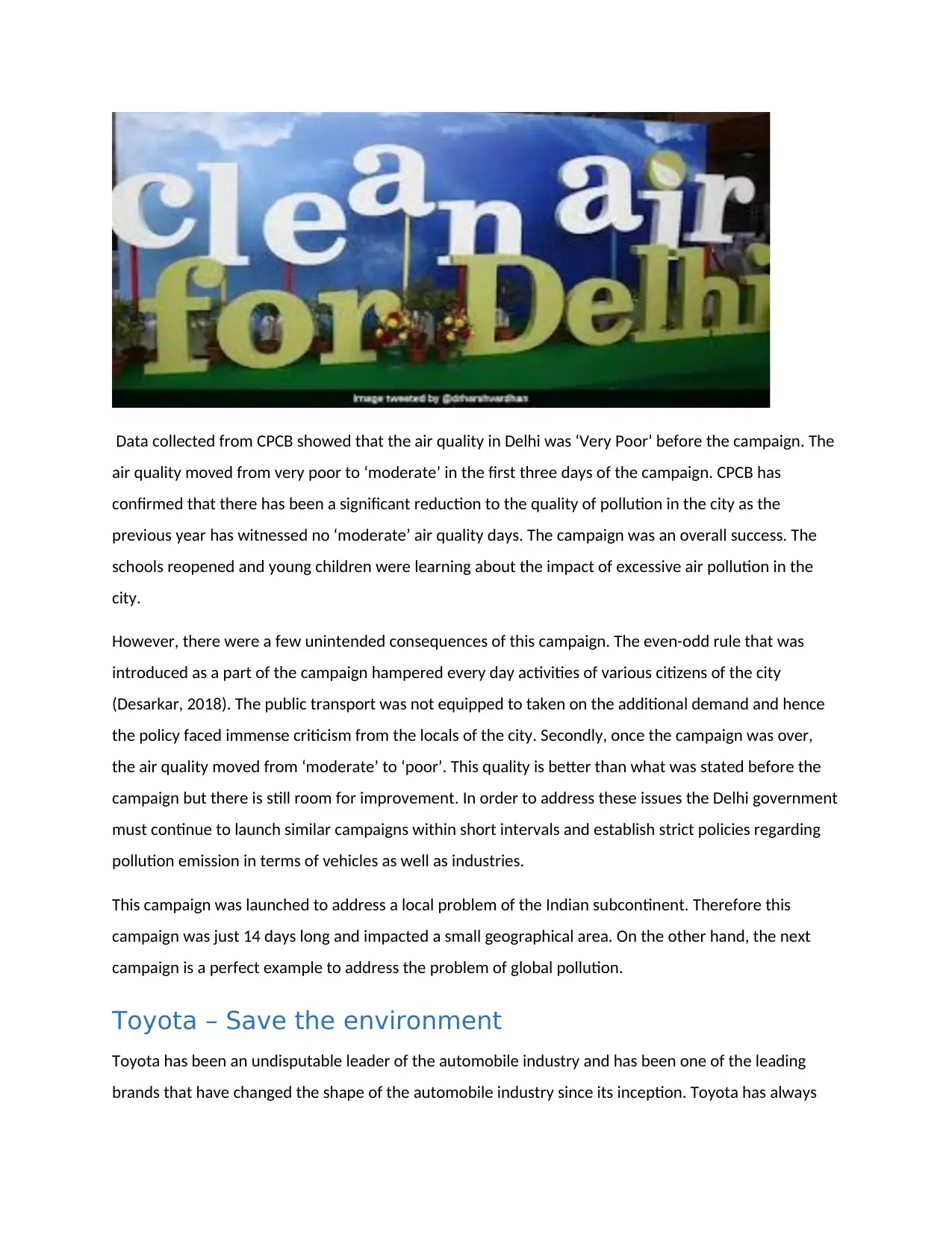
Data collected from CPCB showed that the air quality in Delhi was ‘Very Poor’ before the campaign. The
air quality moved from very poor to ‘moderate’ in the first three days of the campaign. CPCB has
confirmed that there has been a significant reduction to the quality of pollution in the city as the
previous year has witnessed no ‘moderate’ air quality days. The campaign was an overall success. The
schools reopened and young children were learning about the impact of excessive air pollution in the
city.
However, there were a few unintended consequences of this campaign. The even-odd rule that was
introduced as a part of the campaign hampered every day activities of various citizens of the city
(Desarkar, 2018). The public transport was not equipped to taken on the additional demand and hence
the policy faced immense criticism from the locals of the city. Secondly, once the campaign was over,
the air quality moved from ‘moderate’ to ‘poor’. This quality is better than what was stated before the
campaign but there is still room for improvement. In order to address these issues the Delhi government
must continue to launch similar campaigns within short intervals and establish strict policies regarding
pollution emission in terms of vehicles as well as industries.
This campaign was launched to address a local problem of the Indian subcontinent. Therefore this
campaign was just 14 days long and impacted a small geographical area. On the other hand, the next
campaign is a perfect example to address the problem of global pollution.
Toyota – Save the environment
Toyota has been an undisputable leader of the automobile industry and has been one of the leading
brands that have changed the shape of the automobile industry since its inception. Toyota has always
air quality moved from very poor to ‘moderate’ in the first three days of the campaign. CPCB has
confirmed that there has been a significant reduction to the quality of pollution in the city as the
previous year has witnessed no ‘moderate’ air quality days. The campaign was an overall success. The
schools reopened and young children were learning about the impact of excessive air pollution in the
city.
However, there were a few unintended consequences of this campaign. The even-odd rule that was
introduced as a part of the campaign hampered every day activities of various citizens of the city
(Desarkar, 2018). The public transport was not equipped to taken on the additional demand and hence
the policy faced immense criticism from the locals of the city. Secondly, once the campaign was over,
the air quality moved from ‘moderate’ to ‘poor’. This quality is better than what was stated before the
campaign but there is still room for improvement. In order to address these issues the Delhi government
must continue to launch similar campaigns within short intervals and establish strict policies regarding
pollution emission in terms of vehicles as well as industries.
This campaign was launched to address a local problem of the Indian subcontinent. Therefore this
campaign was just 14 days long and impacted a small geographical area. On the other hand, the next
campaign is a perfect example to address the problem of global pollution.
Toyota – Save the environment
Toyota has been an undisputable leader of the automobile industry and has been one of the leading
brands that have changed the shape of the automobile industry since its inception. Toyota has always
Paraphrase This Document
Need a fresh take? Get an instant paraphrase of this document with our AI Paraphraser
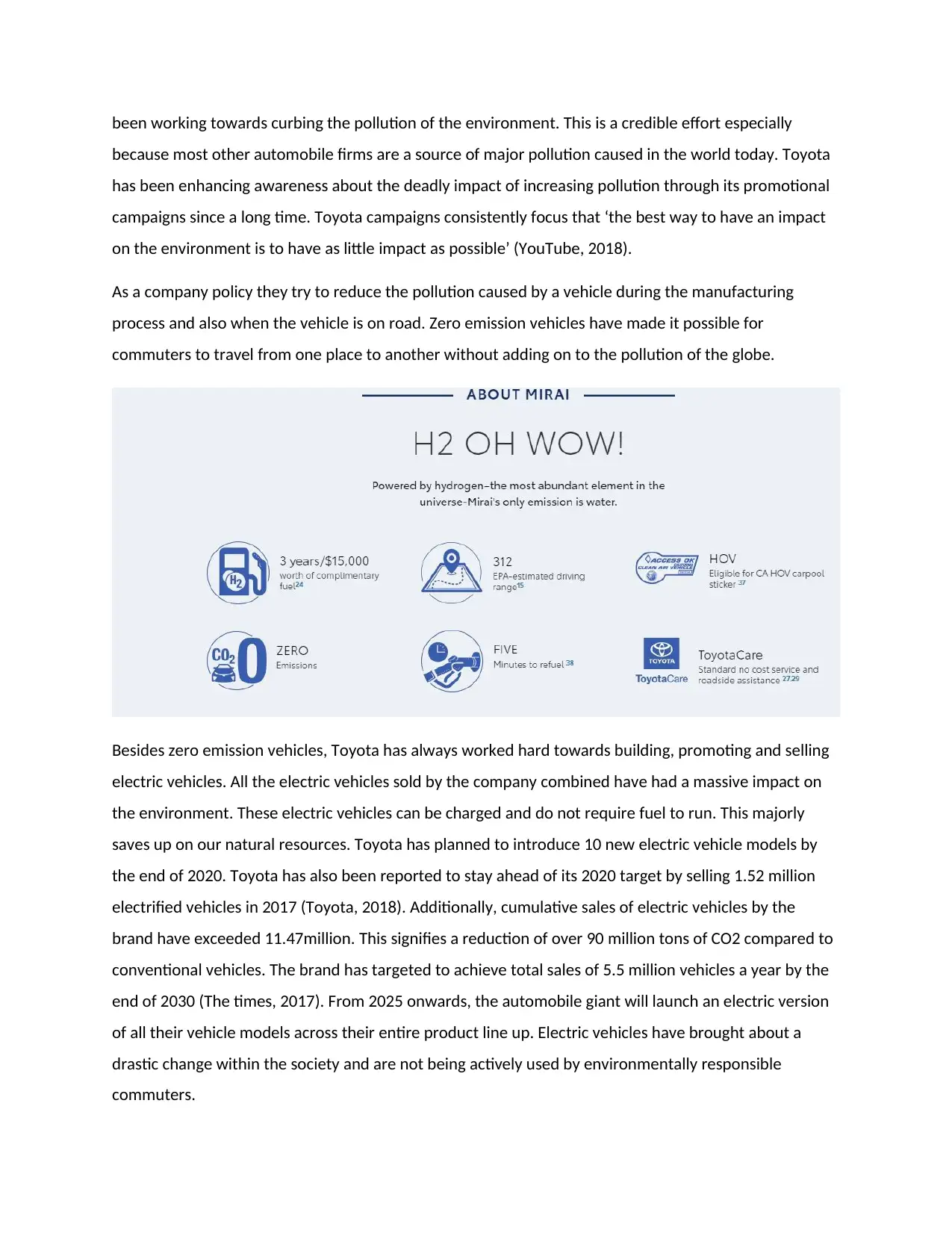
been working towards curbing the pollution of the environment. This is a credible effort especially
because most other automobile firms are a source of major pollution caused in the world today. Toyota
has been enhancing awareness about the deadly impact of increasing pollution through its promotional
campaigns since a long time. Toyota campaigns consistently focus that ‘the best way to have an impact
on the environment is to have as little impact as possible’ (YouTube, 2018).
As a company policy they try to reduce the pollution caused by a vehicle during the manufacturing
process and also when the vehicle is on road. Zero emission vehicles have made it possible for
commuters to travel from one place to another without adding on to the pollution of the globe.
Besides zero emission vehicles, Toyota has always worked hard towards building, promoting and selling
electric vehicles. All the electric vehicles sold by the company combined have had a massive impact on
the environment. These electric vehicles can be charged and do not require fuel to run. This majorly
saves up on our natural resources. Toyota has planned to introduce 10 new electric vehicle models by
the end of 2020. Toyota has also been reported to stay ahead of its 2020 target by selling 1.52 million
electrified vehicles in 2017 (Toyota, 2018). Additionally, cumulative sales of electric vehicles by the
brand have exceeded 11.47million. This signifies a reduction of over 90 million tons of CO2 compared to
conventional vehicles. The brand has targeted to achieve total sales of 5.5 million vehicles a year by the
end of 2030 (The times, 2017). From 2025 onwards, the automobile giant will launch an electric version
of all their vehicle models across their entire product line up. Electric vehicles have brought about a
drastic change within the society and are not being actively used by environmentally responsible
commuters.
because most other automobile firms are a source of major pollution caused in the world today. Toyota
has been enhancing awareness about the deadly impact of increasing pollution through its promotional
campaigns since a long time. Toyota campaigns consistently focus that ‘the best way to have an impact
on the environment is to have as little impact as possible’ (YouTube, 2018).
As a company policy they try to reduce the pollution caused by a vehicle during the manufacturing
process and also when the vehicle is on road. Zero emission vehicles have made it possible for
commuters to travel from one place to another without adding on to the pollution of the globe.
Besides zero emission vehicles, Toyota has always worked hard towards building, promoting and selling
electric vehicles. All the electric vehicles sold by the company combined have had a massive impact on
the environment. These electric vehicles can be charged and do not require fuel to run. This majorly
saves up on our natural resources. Toyota has planned to introduce 10 new electric vehicle models by
the end of 2020. Toyota has also been reported to stay ahead of its 2020 target by selling 1.52 million
electrified vehicles in 2017 (Toyota, 2018). Additionally, cumulative sales of electric vehicles by the
brand have exceeded 11.47million. This signifies a reduction of over 90 million tons of CO2 compared to
conventional vehicles. The brand has targeted to achieve total sales of 5.5 million vehicles a year by the
end of 2030 (The times, 2017). From 2025 onwards, the automobile giant will launch an electric version
of all their vehicle models across their entire product line up. Electric vehicles have brought about a
drastic change within the society and are not being actively used by environmentally responsible
commuters.
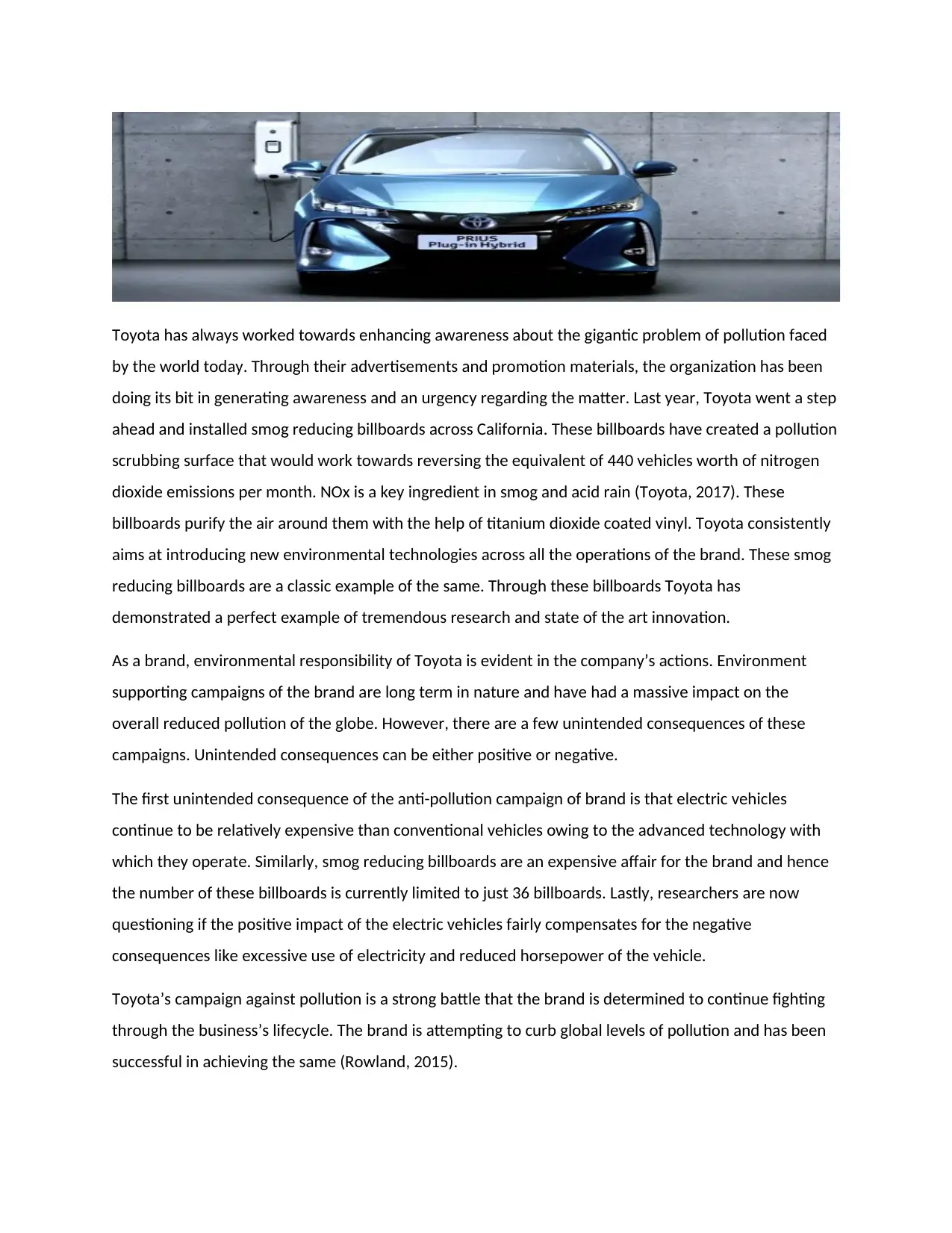
Toyota has always worked towards enhancing awareness about the gigantic problem of pollution faced
by the world today. Through their advertisements and promotion materials, the organization has been
doing its bit in generating awareness and an urgency regarding the matter. Last year, Toyota went a step
ahead and installed smog reducing billboards across California. These billboards have created a pollution
scrubbing surface that would work towards reversing the equivalent of 440 vehicles worth of nitrogen
dioxide emissions per month. NOx is a key ingredient in smog and acid rain (Toyota, 2017). These
billboards purify the air around them with the help of titanium dioxide coated vinyl. Toyota consistently
aims at introducing new environmental technologies across all the operations of the brand. These smog
reducing billboards are a classic example of the same. Through these billboards Toyota has
demonstrated a perfect example of tremendous research and state of the art innovation.
As a brand, environmental responsibility of Toyota is evident in the company’s actions. Environment
supporting campaigns of the brand are long term in nature and have had a massive impact on the
overall reduced pollution of the globe. However, there are a few unintended consequences of these
campaigns. Unintended consequences can be either positive or negative.
The first unintended consequence of the anti-pollution campaign of brand is that electric vehicles
continue to be relatively expensive than conventional vehicles owing to the advanced technology with
which they operate. Similarly, smog reducing billboards are an expensive affair for the brand and hence
the number of these billboards is currently limited to just 36 billboards. Lastly, researchers are now
questioning if the positive impact of the electric vehicles fairly compensates for the negative
consequences like excessive use of electricity and reduced horsepower of the vehicle.
Toyota’s campaign against pollution is a strong battle that the brand is determined to continue fighting
through the business’s lifecycle. The brand is attempting to curb global levels of pollution and has been
successful in achieving the same (Rowland, 2015).
by the world today. Through their advertisements and promotion materials, the organization has been
doing its bit in generating awareness and an urgency regarding the matter. Last year, Toyota went a step
ahead and installed smog reducing billboards across California. These billboards have created a pollution
scrubbing surface that would work towards reversing the equivalent of 440 vehicles worth of nitrogen
dioxide emissions per month. NOx is a key ingredient in smog and acid rain (Toyota, 2017). These
billboards purify the air around them with the help of titanium dioxide coated vinyl. Toyota consistently
aims at introducing new environmental technologies across all the operations of the brand. These smog
reducing billboards are a classic example of the same. Through these billboards Toyota has
demonstrated a perfect example of tremendous research and state of the art innovation.
As a brand, environmental responsibility of Toyota is evident in the company’s actions. Environment
supporting campaigns of the brand are long term in nature and have had a massive impact on the
overall reduced pollution of the globe. However, there are a few unintended consequences of these
campaigns. Unintended consequences can be either positive or negative.
The first unintended consequence of the anti-pollution campaign of brand is that electric vehicles
continue to be relatively expensive than conventional vehicles owing to the advanced technology with
which they operate. Similarly, smog reducing billboards are an expensive affair for the brand and hence
the number of these billboards is currently limited to just 36 billboards. Lastly, researchers are now
questioning if the positive impact of the electric vehicles fairly compensates for the negative
consequences like excessive use of electricity and reduced horsepower of the vehicle.
Toyota’s campaign against pollution is a strong battle that the brand is determined to continue fighting
through the business’s lifecycle. The brand is attempting to curb global levels of pollution and has been
successful in achieving the same (Rowland, 2015).
⊘ This is a preview!⊘
Do you want full access?
Subscribe today to unlock all pages.

Trusted by 1+ million students worldwide
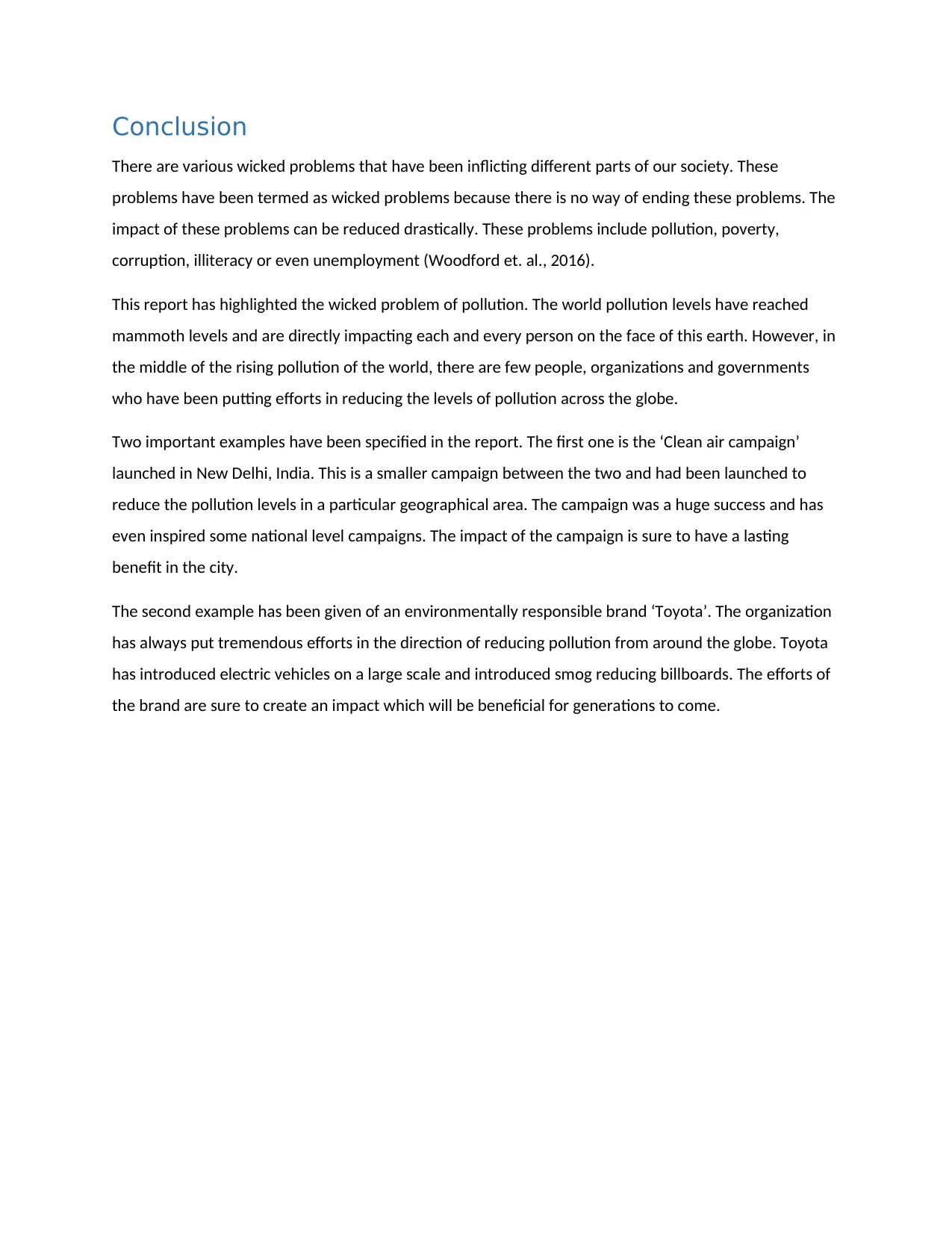
Conclusion
There are various wicked problems that have been inflicting different parts of our society. These
problems have been termed as wicked problems because there is no way of ending these problems. The
impact of these problems can be reduced drastically. These problems include pollution, poverty,
corruption, illiteracy or even unemployment (Woodford et. al., 2016).
This report has highlighted the wicked problem of pollution. The world pollution levels have reached
mammoth levels and are directly impacting each and every person on the face of this earth. However, in
the middle of the rising pollution of the world, there are few people, organizations and governments
who have been putting efforts in reducing the levels of pollution across the globe.
Two important examples have been specified in the report. The first one is the ‘Clean air campaign’
launched in New Delhi, India. This is a smaller campaign between the two and had been launched to
reduce the pollution levels in a particular geographical area. The campaign was a huge success and has
even inspired some national level campaigns. The impact of the campaign is sure to have a lasting
benefit in the city.
The second example has been given of an environmentally responsible brand ‘Toyota’. The organization
has always put tremendous efforts in the direction of reducing pollution from around the globe. Toyota
has introduced electric vehicles on a large scale and introduced smog reducing billboards. The efforts of
the brand are sure to create an impact which will be beneficial for generations to come.
There are various wicked problems that have been inflicting different parts of our society. These
problems have been termed as wicked problems because there is no way of ending these problems. The
impact of these problems can be reduced drastically. These problems include pollution, poverty,
corruption, illiteracy or even unemployment (Woodford et. al., 2016).
This report has highlighted the wicked problem of pollution. The world pollution levels have reached
mammoth levels and are directly impacting each and every person on the face of this earth. However, in
the middle of the rising pollution of the world, there are few people, organizations and governments
who have been putting efforts in reducing the levels of pollution across the globe.
Two important examples have been specified in the report. The first one is the ‘Clean air campaign’
launched in New Delhi, India. This is a smaller campaign between the two and had been launched to
reduce the pollution levels in a particular geographical area. The campaign was a huge success and has
even inspired some national level campaigns. The impact of the campaign is sure to have a lasting
benefit in the city.
The second example has been given of an environmentally responsible brand ‘Toyota’. The organization
has always put tremendous efforts in the direction of reducing pollution from around the globe. Toyota
has introduced electric vehicles on a large scale and introduced smog reducing billboards. The efforts of
the brand are sure to create an impact which will be beneficial for generations to come.
Paraphrase This Document
Need a fresh take? Get an instant paraphrase of this document with our AI Paraphraser
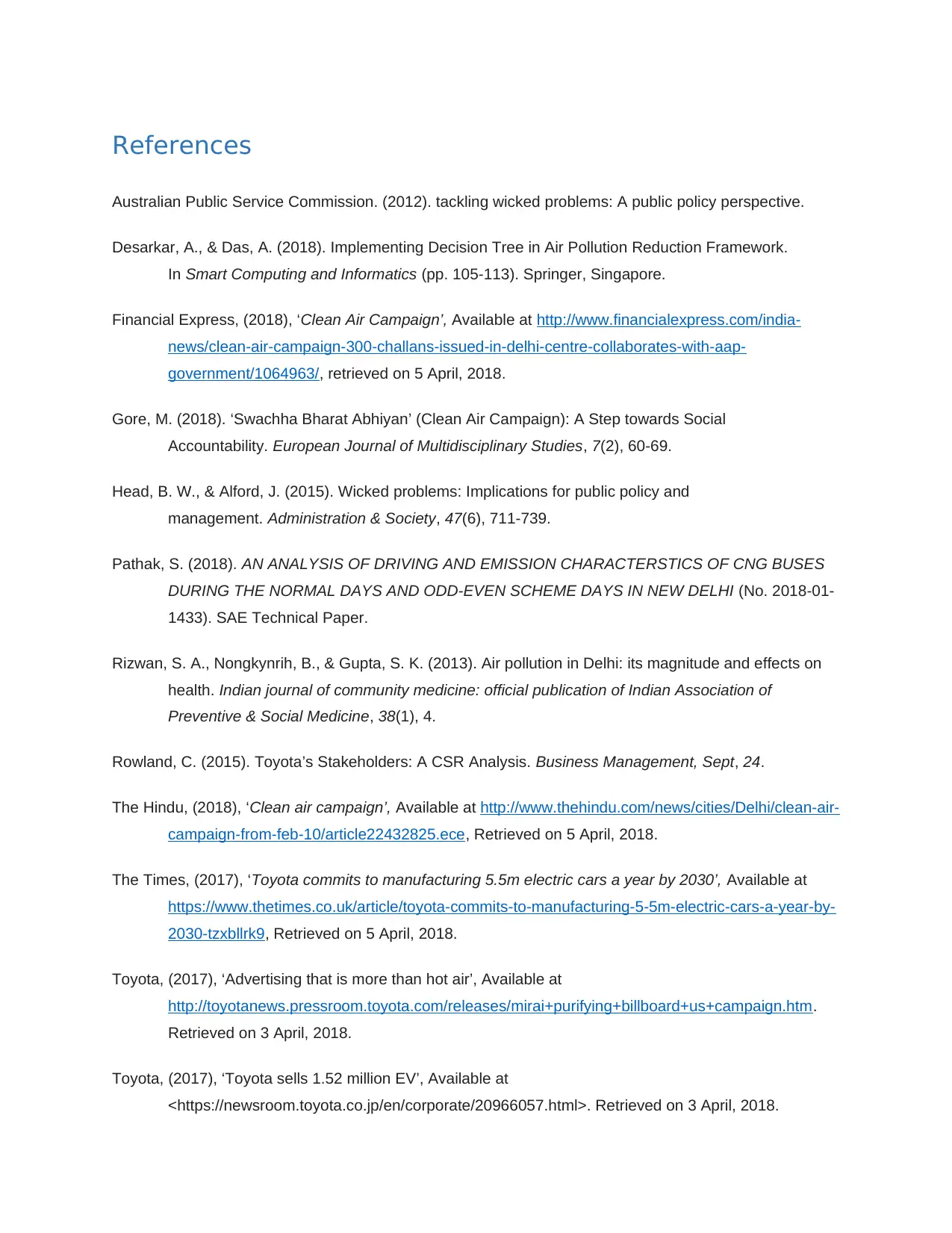
References
Australian Public Service Commission. (2012). tackling wicked problems: A public policy perspective.
Desarkar, A., & Das, A. (2018). Implementing Decision Tree in Air Pollution Reduction Framework.
In Smart Computing and Informatics (pp. 105-113). Springer, Singapore.
Financial Express, (2018), ‘Clean Air Campaign’, Available at http://www.financialexpress.com/india-
news/clean-air-campaign-300-challans-issued-in-delhi-centre-collaborates-with-aap-
government/1064963/, retrieved on 5 April, 2018.
Gore, M. (2018). ‘Swachha Bharat Abhiyan’ (Clean Air Campaign): A Step towards Social
Accountability. European Journal of Multidisciplinary Studies, 7(2), 60-69.
Head, B. W., & Alford, J. (2015). Wicked problems: Implications for public policy and
management. Administration & Society, 47(6), 711-739.
Pathak, S. (2018). AN ANALYSIS OF DRIVING AND EMISSION CHARACTERSTICS OF CNG BUSES
DURING THE NORMAL DAYS AND ODD-EVEN SCHEME DAYS IN NEW DELHI (No. 2018-01-
1433). SAE Technical Paper.
Rizwan, S. A., Nongkynrih, B., & Gupta, S. K. (2013). Air pollution in Delhi: its magnitude and effects on
health. Indian journal of community medicine: official publication of Indian Association of
Preventive & Social Medicine, 38(1), 4.
Rowland, C. (2015). Toyota’s Stakeholders: A CSR Analysis. Business Management, Sept, 24.
The Hindu, (2018), ‘Clean air campaign’, Available at http://www.thehindu.com/news/cities/Delhi/clean-air-
campaign-from-feb-10/article22432825.ece, Retrieved on 5 April, 2018.
The Times, (2017), ‘Toyota commits to manufacturing 5.5m electric cars a year by 2030’, Available at
https://www.thetimes.co.uk/article/toyota-commits-to-manufacturing-5-5m-electric-cars-a-year-by-
2030-tzxbllrk9, Retrieved on 5 April, 2018.
Toyota, (2017), ‘Advertising that is more than hot air’, Available at
http://toyotanews.pressroom.toyota.com/releases/mirai+purifying+billboard+us+campaign.htm.
Retrieved on 3 April, 2018.
Toyota, (2017), ‘Toyota sells 1.52 million EV’, Available at
<https://newsroom.toyota.co.jp/en/corporate/20966057.html>. Retrieved on 3 April, 2018.
Australian Public Service Commission. (2012). tackling wicked problems: A public policy perspective.
Desarkar, A., & Das, A. (2018). Implementing Decision Tree in Air Pollution Reduction Framework.
In Smart Computing and Informatics (pp. 105-113). Springer, Singapore.
Financial Express, (2018), ‘Clean Air Campaign’, Available at http://www.financialexpress.com/india-
news/clean-air-campaign-300-challans-issued-in-delhi-centre-collaborates-with-aap-
government/1064963/, retrieved on 5 April, 2018.
Gore, M. (2018). ‘Swachha Bharat Abhiyan’ (Clean Air Campaign): A Step towards Social
Accountability. European Journal of Multidisciplinary Studies, 7(2), 60-69.
Head, B. W., & Alford, J. (2015). Wicked problems: Implications for public policy and
management. Administration & Society, 47(6), 711-739.
Pathak, S. (2018). AN ANALYSIS OF DRIVING AND EMISSION CHARACTERSTICS OF CNG BUSES
DURING THE NORMAL DAYS AND ODD-EVEN SCHEME DAYS IN NEW DELHI (No. 2018-01-
1433). SAE Technical Paper.
Rizwan, S. A., Nongkynrih, B., & Gupta, S. K. (2013). Air pollution in Delhi: its magnitude and effects on
health. Indian journal of community medicine: official publication of Indian Association of
Preventive & Social Medicine, 38(1), 4.
Rowland, C. (2015). Toyota’s Stakeholders: A CSR Analysis. Business Management, Sept, 24.
The Hindu, (2018), ‘Clean air campaign’, Available at http://www.thehindu.com/news/cities/Delhi/clean-air-
campaign-from-feb-10/article22432825.ece, Retrieved on 5 April, 2018.
The Times, (2017), ‘Toyota commits to manufacturing 5.5m electric cars a year by 2030’, Available at
https://www.thetimes.co.uk/article/toyota-commits-to-manufacturing-5-5m-electric-cars-a-year-by-
2030-tzxbllrk9, Retrieved on 5 April, 2018.
Toyota, (2017), ‘Advertising that is more than hot air’, Available at
http://toyotanews.pressroom.toyota.com/releases/mirai+purifying+billboard+us+campaign.htm.
Retrieved on 3 April, 2018.
Toyota, (2017), ‘Toyota sells 1.52 million EV’, Available at
<https://newsroom.toyota.co.jp/en/corporate/20966057.html>. Retrieved on 3 April, 2018.

Woodford, D. J., Richardson, D. M., MacIsaac, H. J., Mandrak, N. E., Van Wilgen, B. W., Wilson, J. R., &
Weyl, O. L. (2016). Confronting the wicked problem of managing biological
invasions. NeoBiota, 31, 63.
YouTube, (2018), ‘Toyota Prius ad’, Available at https://www.youtube.com/watch?v=kQsNs8SWCkU,
retrieved on 3 April, 2018.
Weyl, O. L. (2016). Confronting the wicked problem of managing biological
invasions. NeoBiota, 31, 63.
YouTube, (2018), ‘Toyota Prius ad’, Available at https://www.youtube.com/watch?v=kQsNs8SWCkU,
retrieved on 3 April, 2018.
⊘ This is a preview!⊘
Do you want full access?
Subscribe today to unlock all pages.

Trusted by 1+ million students worldwide
1 out of 9
Your All-in-One AI-Powered Toolkit for Academic Success.
+13062052269
info@desklib.com
Available 24*7 on WhatsApp / Email
![[object Object]](/_next/static/media/star-bottom.7253800d.svg)
Unlock your academic potential
Copyright © 2020–2025 A2Z Services. All Rights Reserved. Developed and managed by ZUCOL.